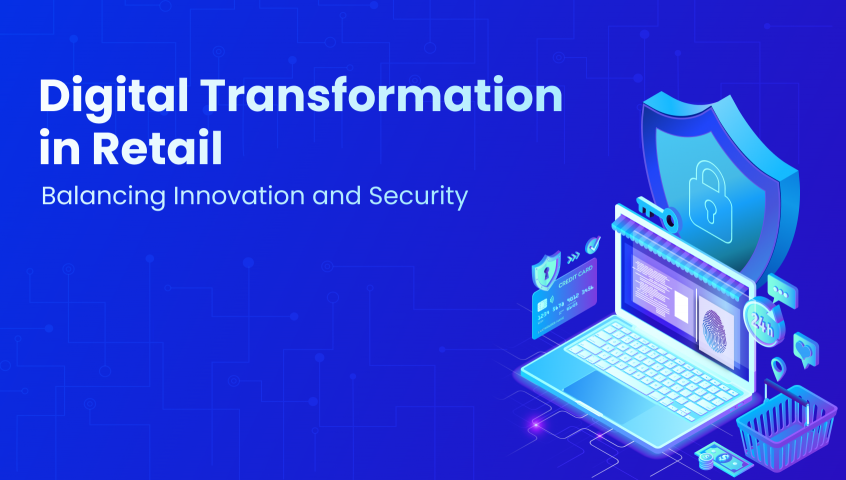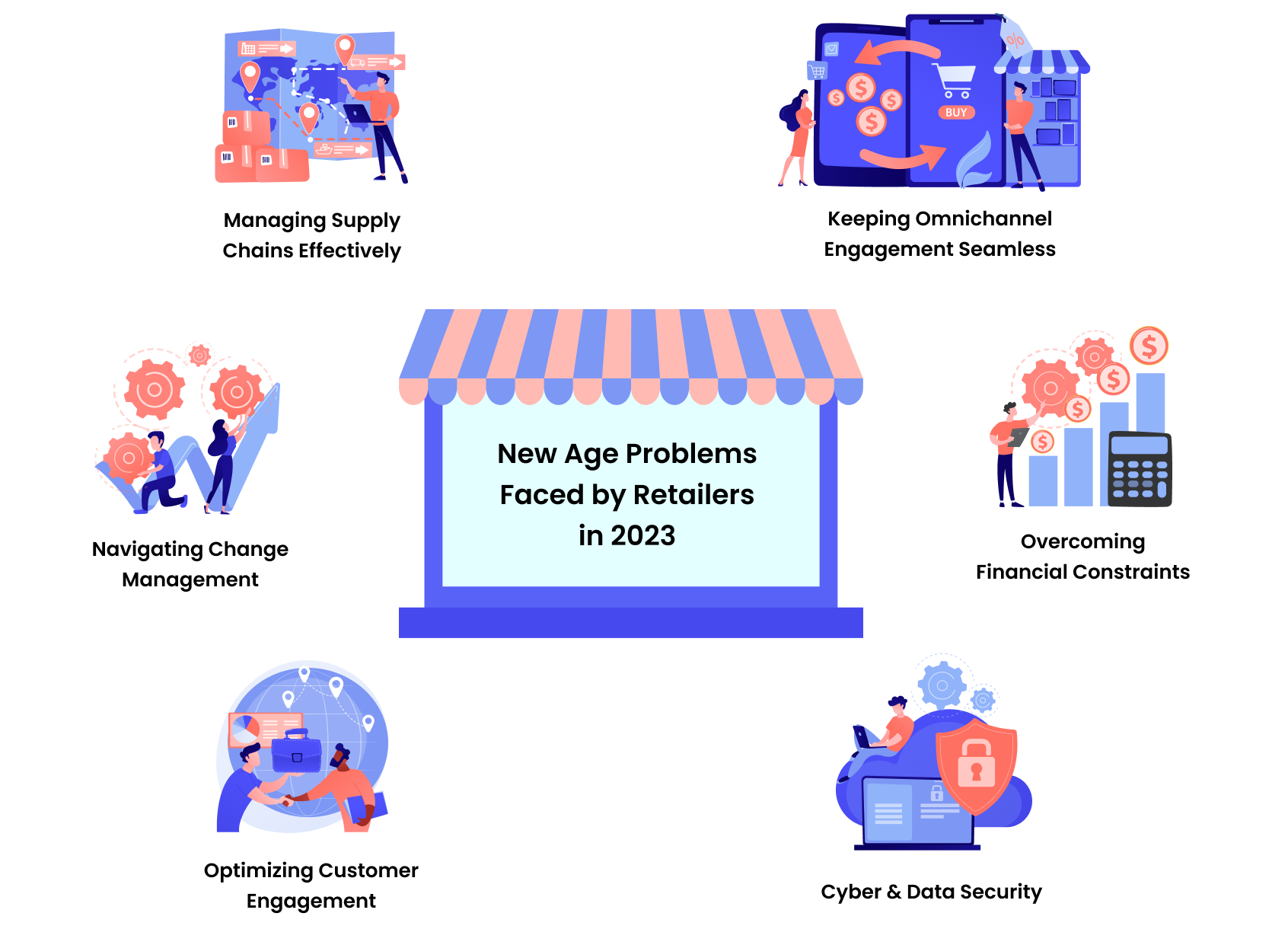
In recent years, the retail industry has undergone a remarkable digital transformation. This evolution, while introducing innovative commercial models with partners, customers, and suppliers, also brings newfound risks. The surge in interconnected devices, online transactions, and cloud storage poses severe challenges for cybersecurity teams. Retailers are compelled to bolster security to protect systems, data, and customers against cyber threats. While digital transformation holds immense promise for the retail sector, it's crucial to acknowledge the associated risks, especially in cybersecurity and data privacy. This article delves into the significance of these concerns in retail and offers insights on risk mitigation.
Digital Transformation in Retail: Accelerators and Challenges
The digital age presents retailers with enticing opportunities to boost operational efficiency and pivot towards customer-centric business models. Digital transformation spans beyond just technology—it encompasses people and their evolving mindsets. However, initiating this transformation can pose challenges, especially when existing methodologies and infrastructures require significant shifts. Here are some pivotal drivers for digital transformation in the retail sector:
- Agile and DevOps: By harnessing Agile and DevOps, companies can outpace competitors through timely evaluation, idea validation, and the scaling of pioneering solutions. This approach ensures adaptability and efficiency. Particularly, DevOps refines the Agile SDLC, enabling businesses to consistently introduce new features.
- Automation and AI: Artificial intelligence and automation hold the potential to radically reshape retail business models. Forward-thinking leaders formulate robust strategies for AI, robotic process automation, and IT automation. Rather than merely perceiving these technologies as cost-cutting tools, they see them as vehicles to amplify human potential. Their teams possess the expertise to adeptly deploy automation and AI, aligning them with organizational goals.
- Design: Empowered by design competencies, firms can reimagine their entire operational framework, including customer interactions. Retailers harness technology to meet customer demands innovatively, leveraging superior design acumen. Design extends beyond mere user experience. It's integrated holistically, ensuring a broader set of employees across various sectors are responsible for crafting offerings that heighten user satisfaction.
- Learning: A skills gap poses formidable challenges for retailers. Inadequately trained staff can jeopardize operational smoothness and customer relationships. Perpetual learning is paramount to cultivate a workforce ready for the demands of digital transformation. The emphasis is on fostering agility, proactive responses, and initiative in employees, enabling them to seize lucrative prospects ushered in by emerging tech and novel business paradigms.
Proximity: Even in a digitally connected world, geographical distances can pose hurdles for retail enterprises. Proximity in product and IT initiatives augments collaboration and surmounts inherent challenges. The magic happens when firms strategically align their teams, championing tight-knit collaboration throughout a project's lifespan.

Retail Cybersecurity and Data Privacy Threats You Must Know!
The holiday shopping season is a goldmine for hackers. As online retail businesses roll out promotions and sales, there's a surge in transactions. Many items are marked down on online platforms, drawing in vast numbers of customers who transact using credit cards and online banking. While the increased footfall requires these stores to prioritize customer service and other essentials, cybersecurity often takes a backseat. Here are some common security challenges retailers encounter:
- Phishing Scams: The retail sector ranks high on the list of industries frequently targeted by phishing attacks. These scams, prevalent across various industries, employ deceptive emails or texts, urging individuals to inadvertently share sensitive information. These emails might impersonate messages from the company's associates, be it vendors, partners, or customers. Often, they either solicit information or urge users to click on deceptive links, potentially initiating malware downloads or unauthorized data access.
- IoT Technology Attacks: The pandemic has notably heightened the use of wireless and contactless payment methods. While devices like Square Terminals simplify and secure contactless payments for customers, they aren't immune to hacking attempts.
- Supply-chain Attacks: Instead of directly attacking major retailers, crafty hackers now target the third-party vendors in a retail company's supply chain, aiming to infiltrate the main target through a security loophole. Given the intricate web of products and services in the retail supply chain, this sector presents numerous potential vulnerabilities. A breach at any supplier can have cascading implications for dependent retailers.
- Advanced Persistent Threats (APTs): APTs necessitate stealthy, prolonged access to an organization's network. Orchestrated by resource-rich entities, possibly state-backed, these attacks aim to discreetly extract information over an extended period. While governments are often in the crosshairs of APTs, prominent retailers aren't exempt. Their increasing dependence on cloud solutions and intricate IT infrastructures broadens their exposure, complicating the task of spotting and neutralizing threats.
5 Essential Cybersecurity and Data Privacy Tips for Retailers
The increasing digital transformation of the retail sector brings with it the escalated risks of cyberattacks. In today's hyper-connected landscape, proactive cybersecurity measures aren't a luxury; they're a necessity. Forward-thinking retailers are now prioritizing the mitigation of the most menacing cyber threats. Here are some indispensable steps retailers should consider:
- Employee Security Awareness Training:
- Significance: The human element remains the weakest link in the cybersecurity chain. A well-informed employee can be the first line of defense against cyber threats.
- Training Modules: Beyond basic awareness, comprehensive training should encompass real-world examples, deep dives into sophisticated attack vectors, and the practical application of protective measures.
- Feedback and Iteration: Use regular mock drills, like simulated phishing campaigns, to measure employee responsiveness. Analyze the results and refine the training modules for maximal efficacy.
- Implement MFA for Enhanced Security:
- Why MFA: Passwords alone have proven insufficient. Attackers use various techniques, from brute force attacks to sophisticated algorithms, to crack passwords. MFA adds layered protection.
- Diverse Authentication Methods: Introduce biometrics, smart cards, and security tokens. Employ a dynamic combination to ensure robustness.
- User Experience: While security is paramount, ensure MFA processes are user-friendly. A cumbersome process might deter users or lead to workarounds that could introduce vulnerabilities.
- PCI CompliEnsureance:
- Beyond Compliance: While PCI DSS sets a minimum security threshold, consider it a foundation. Strive for practices that exceed these standards.
- Internal Audits: Regularly conduct internal reviews to ensure all systems and processes align with compliance requirements. Identify potential weak spots before they become actual vulnerabilities.
- Consumer Confidence: Achieving and maintaining PCI compliance is also a trust signal to consumers, assuring them of the safety of their financial data.
- Stay Updated on the Latest Threats:
- Dynamic Threat Landscape: Cyber threats aren't static. New vulnerabilities, malware, and attack vectors emerge daily. Adopt a proactive stance.
- Threat Intelligence Platforms: Invest in platforms that provide real-time information about emerging threats, helping you pre-empt potential attacks.
- Collaborative Defense: Consider joining or forming industry alliances that share threat intelligence, amplifying collective defense capabilities.
- Prepare an Emergency Response Plan:
- Anticipate, Don't Just React: While defense mechanisms are essential, anticipating potential attacks can save significant resources.
- Scenario Planning: Use simulated cyberattack scenarios to test and refine your response strategy. This 'fire-drill' approach ensures that when a real threat emerges, your team isn't caught off-guard.
- Post-Incident Analysis: After addressing a threat, conduct a thorough analysis to understand the root cause, improve defense mechanisms, and refine your response strategy.
In the era of digital shopping and omnichannel retail experiences, ensuring cybersecurity isn't just about protecting data; it's about safeguarding brand reputation, trust, and ultimately, the bottom line. This entails collaborating with a managed security service provider (MSSP), implementing robust security software and systems, providing regular personnel training, staying updated on the latest cybersecurity trends and best practices, and more. In essence, Partner with experts, invest in state-of-the-art tools, and foster a culture of cybersecurity awareness from the boardroom to the storefront. Reach out to us at info@qentelli.com for a tailored cybersecurity strategy. Let's champion a secure, trustworthy digital retail future together!

